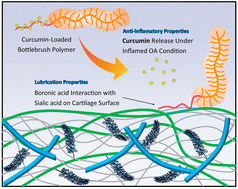Bottlebrush polymer with dual functionality for osteoarthritis treatment: curcumin delivery and lubrication properties†
Abstract
Herein, inspired by the structure of phosphatidylcholine lipid (a typical cartilage matrix) with the presence of zwitterionic charges, a bottlebrush polymer was developed, namely poly(4-(methyl)propenamidophenylboronic acid)-co-poly(methyl methacrylate)-b-((poly(2-(2-bromoisobutyryloxy)ethyl methacrylate)-co-poly(methyl methacrylate))-g-poly-(2-methacryloyloxyethyl phosphorylcholine)) via atom transfer radical polymerization (ATRP) and reversible addition–fragmentation chain-transfer radical polymerization (RAFT). The biomimetic bottlebrush included two main regions responsible for lubrication and drug loading. The brush zone could enhance the lubrication due to the formation of a tenacious hydration layer surrounding the zwitterionic charges of poly(2-methacryloyloxyethyl phosphorylcholine) brush polymer (PMPC), while the anchoring zone was responsible for the local delivery of curcumin as an anti-inflammatory drug. The synthesized bottlebrush polymer with integrated features of both enhanced lubrication and sustained drug delivery can be an efficient intra-articular nanomedicine for the treatment of osteoarthritis.



 Please wait while we load your content...
Please wait while we load your content...